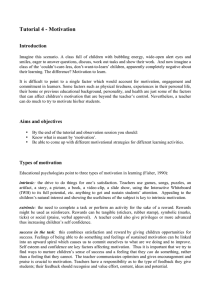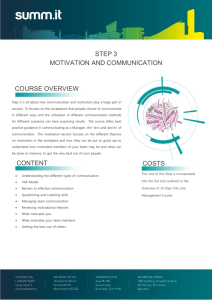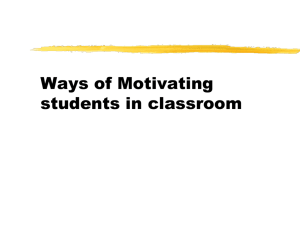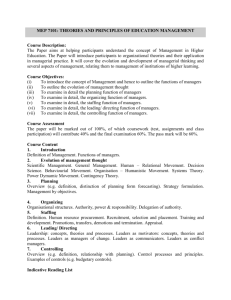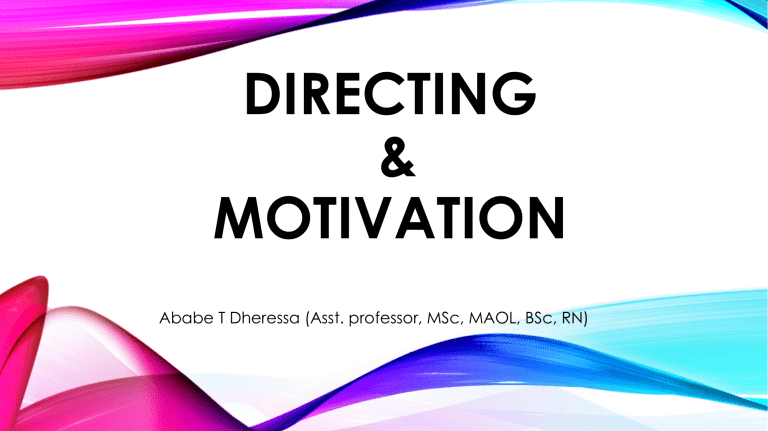
DIRECTING & MOTIVATION Ababe T Dheressa (Asst. professor, MSc, MAOL, BSc, RN) OBJECTIVES • At the end of the session, learners will be able to • Define directing • Describe roles of directing • Discuss motivational theories • Discuss motivation in leadership • Discuss types/practice/theories of motivation actually in your organization DIRECTING • Directing is a function of the manager that gets work done through others. Directing includes five specific concepts: giving directions supervising leading motivating, and communicating DIRECTING… • Giving directions is the first activity and suggests that directions should be clear, concise and consistent and should confirm to the requirements of the situation. • Supervising is concerned with the training and discipline of the work force. It also includes follow up to ensure the prompt execution of orders. • Leading is the ability to inspire and to influence others the attainment of objectives • Motivating is the set of skills the manager uses to help the employee to identify his/her needs and finds ways within the organization to help satisfy them. • Communicating: involves the what, how, by whom, and why of directives or effectively using the communication process. BRAINSTORMING YOUR •LEADERSHIP Vs/& VIEW •MOTIVATION MOTIVATION • The words ‘‘motivation,’’ ‘‘emotion’’ and ‘‘motion’’ all derive from the same Latin root meaning ‘‘to move.’’ • When you want to motivate people to take action, engage their emotions. • Motivation is an individual's level of readiness to perform an action and it comprises all factors that influence, intensify, organize and conduct human behaviour (Rahimic, 2010) MOTIVATION… • Real motivation follows the guidelines set by nature, not the ones set by men. • Motivation is the key to effective leadership, and leadership is the key to effective motivation. • LEADERSHIP = MOTIVATION = EMOTION (Maddock RC @ Fulton R, 1998) • To maximize organizational performance, organization and its managers should understand what really motivates its employees (Lee & Raschke, 2016). D/T PERCEPTIONS TO MOTIVATION ----Research findings • Kenyan health workers- As intrinsic state of willingness and pleasure to do one's work (Mathauer & Imhoff, 2006). • A.A. nurses- Largely as extrinsic rewards (payment, promotion, fringe benefit), this influences intrinsic reward (recognition) (Negussie, 2000) • Nurses in Hawassa public hospitals (Ababe & Getachew, 2020) • prospective encouragement for performance (49.1%) • Getting recognition (39.5%), • Financial incentives (37.3%), getting awards (37.7%), • Pleasure to do one’s work (26.4%), willingness to do one’s work (25%), MOTIVATIONAL THEORIES 1. Maslow need theory (1943) • Lower level needs are first satisfied before higher level need the next MOTIVATIONAL THEORIES… 2. Herzberg motivation theory (Herzberg, Mausner,& Snyderman, 1959). Two factors as motivators and hygiene. Job satisfaction is produced by motivators or intrinsic factors such as achievement and recognition, whereas Hygiene or extrinsic factors, such as pay and job security, produce job dissatisfaction MOTIVATIONAL THEORIES… 3. Vroom’s expectancy theory (Vroom, 1964). based on the belief that employee effort will lead to performance and performance will lead to rewards Effort Performance Reward Rewards may be either positive or negative and the more positive the reward the more likely the employee will be highly motivated. MOTIVATIONAL THEORIES… 4. Adams’s equity and justice theory(Adams, 1963, 1965). • Employees strive for equity between themselves and other employees • Inequity comparisons result in a state of dissonance or tension that motivates an employee to engage in behaviour designed to relieve tension. • For instance, raising or lowering work efforts to re-establish equity, leaving the circumstance that is causing inequity are some of these behaviours. MOTIVATIONAL THEORIES… 5. Cognitive evaluation theory (Deci & Ryan, 1980). Explains the effects of external consequences on internal motivation. If employees are intrinsically motivated, they attribute the cause of their behaviour to internal needs and perform behaviours for intrinsic rewards and satisfaction. However, external elements (e.g., the reward system) may result employee in to questioning the true causes of his/her behaviour. the MOTIVATIONAL THEORIES… 6. Skinner’s reinforcement theory (1953, 1969) Dictates those employees’ behaviours that result in positive outcomes will be repeated, and behaviours that having negative outcomes will not be repeated. Thus, managers should positively reinforce employee behaviours that lead to positive outcomes, for example, with extrinsic rewards. On the contrary, managers should negatively reinforce employee behaviour that leads to negative outcomes (e.g., with performance feedback and/or punishment) Nohria et al., (2008) Four drives that are foundation of Motivation 1. The drive to acquire - the acquisition of scarce goods • E.g. food, clothing, housing and money, travel and entertainment. • This drive tends to be relative – compare with others’. 2. The drive to bond - is associated with strong positive emotions like caring. • This drive accounts for the huge increase in motivation when employees feel proud of belonging to the organization, and for their loss of morale when the organization betrays them. • Bond explains why employees get difficult to break out from the organization or the collague drives that are foundation of Motivation… 3. The drive to comprehend - represents the issue of satisfying employee curiosity and mastering the world around them. As part of their desire to make a meaningful contribution, employees want to take reasonable action and respond to organizational events These employees are motivated by jobs that challenge them and enable them to grow, learn, innovate 4. The drive to defend – allow employees to express their ideas and opinions. Satisfying the drive to defend leads to employees feeling secure and confident. Without this drive, employees show strong negative emotions like fear and resentment. This drive explains employees’ resistance to change TYPES OF MOTIVATION 1. Intrinsic Motivation: Motivation by internal desire • E.g. Doing Sport to loose weight 2. Extrinsic Motivation: by external desires or rewards • E.g. Doing Sport to loose weight by interest of wife/husband, after making formal or informal rewards or recognition 3. Reward/Incentive based motivation: motivation to receive reward once a certain goal is achieved • E.g. A call for 10,000,000 birr after stating a criminal, incentive plan for top performer nurses, guardians etc. TYPES OF MOTIVATION… 4. Fear-based Motivation: motivation of accountability for certain responsibility- Motivated for fear of failure or disappointing others 5. Achievement-based Motivation: being driven to acquire a certain achievements (titles, position, and roles of jobs) 6. Power-based Motivation: To seek more control/be powerful • Bad, but good to make change 7. Affiliation Motivation: • People often say that it is not what we do but who we know that dictates our success. • Those who use this motivation, meet their goals when they connect with others in higher positions than themselves TYPES OF MOTIVATION… 8. Competence Motivation • Type of motivation to push forward or become more competent in a certain area and improve their skills. 9. Attitude Motivation • Is a motivation linked with the way people see the world around them and the way that they see themselves. • For those missing life because of their attitude, this motivation is most important to recover and move forward properly. • E.g. • Attitude change=100% change • “When other see problems, entrepreneurs see opportunities” • “To live the life you love, love the life you live” SYNOPSIS Theories of motivation Gaps of Motivation In your own Organization Your future contributions Practices of motivation Be Motivated Motivate others You will be Effective Leader
